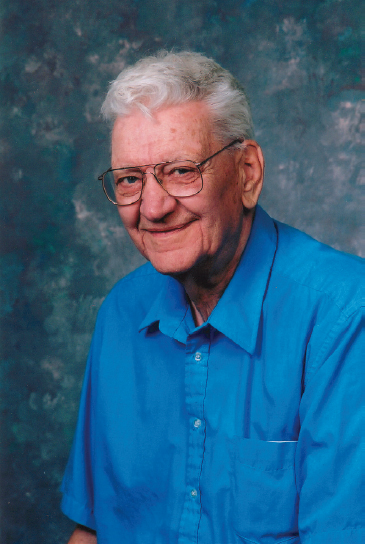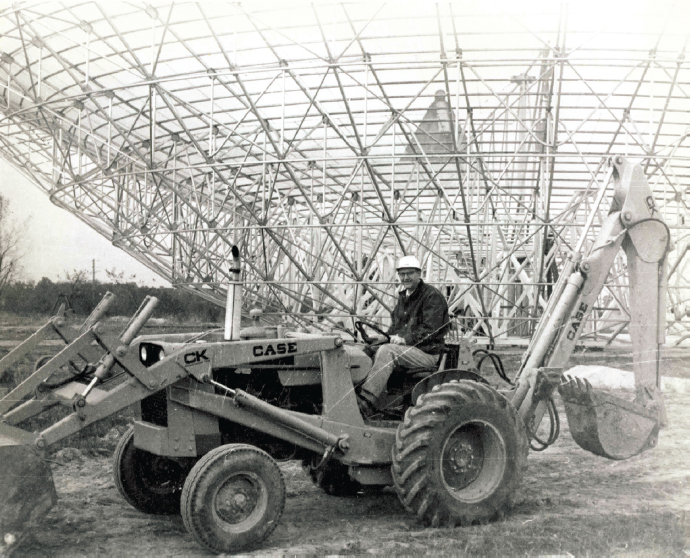

GEORGE W. SWENSON JR.
1922–2017
Elected in 1978
“Contributions to the theory and design of radio telescopes and to radio engineering.”
BY CHESTER S. GARDNER SUBMITTED BY THE NAE HOME SECRETARY
GEORGE W. SWENSON JR., a talented electrical engineer, radio astronomer, and academic administrator, died February 22, 2017, at the age of 94.
He was born in Minneapolis to George W. and Vernie Swenson on September 22, 1922. His family moved to Houghton, Michigan, 6 years later, when his father was hired by the Michigan College of Mining & Technology (now called Michigan Technological University) to establish a department of electrical engineering, which he led for 32 years.
Houghton is in upper Michigan at the base of the Keweenaw Peninsula, which juts north into Lake Superior. George’s boyhood escapades in the surrounding forests and mountains, especially during the long and prodigiously snowy winters, nurtured his lifelong interests in wildlife and wilderness adventure. Predictably, he became a Boy Scout, eventually achieving the Eagle Scout designation. He also became a ham radio operator in high school, earning a class A license at the age of 16.
In his senior year he took an exam for a college scholarship in a national competition sponsored by the Radio Corporation of America (RCA). He was invited to New York City as a semifinalist for a month’s further evaluation by the contest judges and was eventually selected as the winner of a full scholarship
for 4 years of undergraduate study in radio engineering. The die was cast and, although World War II later intervened to complicate his education, in 1940 he enrolled as a freshman in electrical engineering at Michigan Technological University. He eventually completed his BS degree in 1944, by correspondence, while serving on active duty in the US Army and earning a commission as a second lieutenant in the Signal Corps. He earned his SM degree from the Massachusetts Institute of Technology in 1948 and PhD from the University of Wisconsin–Madison in 1951, both in electrical engineering.
George joined the faculty at the University of Illinois at Urbana-Champaign in 1956, after brief stints on the faculties of Washington University in St. Louis, the University of Alaska at Fairbanks, and Michigan State University in East Lansing. He was recruited jointly by the UIUC Electrical Engineering and Astronomy Departments to establish a radio astronomy program and to design and build a radio telescope for observational research by faculty and students. After traveling around the world studying radio astronomy installations in New Zealand, Australia, England, Europe, and the Soviet Union, he conceived, designed, and oversaw the construction of the 400-foot cylindrical radio telescope at the university’s Vermillion River Observatory (VRO) near Danville.
The VRO telescope was used to discover and map thousands of new cosmic radio sources and to produce the first cosmic source catalogue at 600 MHz. George and his colleagues went on to develop a steerable 120-foot dish at the VRO that was used to make observations of complex molecules in the interstellar gas of the Milky Way.
Perhaps the capstone of George’s radio astronomy career was his 4-year tenure in the late 1960s at the National Radio Astronomy Observatory (NRAO) as chair of the Design Committee for the Very Large Array. This seminal work laid the foundation for the design of very long baseline radio interferometers worldwide and eventually led to the construction of the Very Large Array in central New Mexico west of Socorro.
Based on these observations and experience, George later coauthored, with A. Richard Thompson of the NRAO and James
M. Moran of the Harvard-Smithsonian Center for Astrophysics, a comprehensive book on the design and operation of astronomical radio telescopes, Interferometry and Synthesis in Radio Astronomy (John Wiley & Sons, 1986). Its third edition was printed in 2017.
In the fall of 1957, upon hearing the news that the Soviet Union had launched Sputnik I (October 4), George immediately organized Illinois faculty colleagues and students to build a crude radio interferometer beside the campus optical observatory. They made some of the very first detailed observations of radio signals emitted from Sputnik I, observed the significant ionospheric propagation effects on those signals, and produced the first accurate orbital parameters of the satellite. Those observations were published just a few weeks later in the British journal Nature.1
Excited by the radio science that emerged from these initial observations, George was later able to convince NASA and the Department of Defense to fund the construction at UIUC of two small radio beacons, the Nora-Alice 1 and 2 satellites, which were hurled into orbit bolted to the final stages of rockets being used to launch some of the very first military satellites.2 The Nora-Alice observations were used to study radio propagation effects and to probe the structure and electron content of the Earth’s ionosphere.
The consummate storyteller, George loved to reminisce about the design challenges encountered with the Nora-Alice satellites and the resourceful and economical solutions to them. For example, he and his colleagues solved the problem of deploying the Nora-Alice antennas in space by using a carpenter’s tape measure (purchased at a local hardware
___________________
1 King IR, McVittie GC, Swenson GW Jr, Wyatt SP Jr. 1957. Further radio observations of the first satellite. Nature 180:943.
2 In a 1994 “Reminiscence,” George explained that “The payload needed a name, of course. We decided on ‘Nora-Alice’ after the heroine of [cartoonist] Walt Kelly’s ode to the IGY [International Geophysical Year, 1957–58], as recited by Pogo: ‘O, roar a roar for Nora / Nora Alice in the night / For she has seen Aurora / Borealis burning bright.’” In IEEE Antennas and Propagation Magazine 36(2):32–35.
store) for the antenna, and an explosive pin-puller, supplied by an Air Force contractor, to allow the tape measure to unfurl on-orbit.
George had an uncanny ability to combine his personal interest in wildlife and the wilderness with his professional work. During his early years at the University of Alaska, he parlayed his radio engineering skills into numerous adventures in the high Arctic to repair or adjust faulty radio equipment, including a winter trip in a military DC-3 to an ice island research station floating just 30 miles south of the North Pole. He and his climbing companions also made several first ascents of remote mountains in the Alaskan wilderness, including Institute Peak in the Alaska Range, named after the Geophysical Institute at the University of Alaska where they worked.
An avid pilot, at UIUC George worked with William W. Cochran at the Illinois State Natural History Survey. Bill, a pioneer in the art of radio tracking of wildlife, often secured George’s help in tracking birds from the air; George provided piloting services not only in the Midwest but also in the high Canadian wilderness. And while working for the Corps of Engineers he led the development of novel instruments for automatic tracking of radio-tagged wildlife. In later years he served as a technical advisor on wildlife research to the Barrow Colorado Island field station (part of the Smithsonian Tropical Research Institute) in the Panama Canal Zone.
While he is best known for his radio astronomy work, George also had a keen interest in acoustics, which resulted in a textbook early in his career (Principles of Modern Acoustics, Van Nostrand, 1953) and, after he retired from UIUC in 1988, occupied much of his technical work on noise mitigation for the US Army Corps of Engineers. He was a board-certified member of the Institute of Noise Control Engineering.
Beyond his extensive technical expertise, George was a talented administrator. In addition to directing observatories and large engineering studies, at UIUC he served as acting head of the Astronomy Department (1970–72) and head of the Department of Electrical and Computer Engineering (1979–85).
He also participated in the work of the National Research Council. His committee service included the US National Committee for the International Union of Radio Science (1980–82); the Office of Scientific and Engineering Personnel’s Panel on Engineering, Mathematics and Computer Sciences (1983–87); Panel on Airport Passenger Screening (chair; 1995–96); Committee on Commercial Aviation Security (1995–2000); and NASA Technology Roadmap: Robotics, Communications, and Navigation Panel (2011–12).
George’s professional interests were, as amply illustrated, wide ranging and he made important original contributions in all the areas in which he worked. His peers recognized the significance of those contributions by electing him to the National Academy of Engineering in 1978. He was also a life fellow of the Institute of Electrical and Electronics Engineers (IEEE) and American Association for the Advancement of Science, and a Guggenheim fellow.
George loved wilderness adventure, but he was definitely not a loner and sought companionship for his adventures with family members and professional colleagues. For their honeymoon, George took his new wife Janice on a bush pilot’s tour of Alaska, with him serving as the bush pilot! He was an avid bird watcher, conservationist, and canoeist who paddled much of the shoreline of Isle Royale in Lake Superior and circumnavigated the Keweenaw Peninsula. He and Janice donated 80 acres of Keweenaw woods to the Michigan Nature Association; the land is now the Gratiot Lake Overlook Nature Sanctuary.
He loved to tell stories about his professional exploits and wilderness adventures and, an excellent writer, in later years he published versions of many of those stories in The Bridge of Eta Kappa Nu, IEEE’s international electrical and computer engineering honor society.
George was greatly admired by friends and colleagues for his absolute integrity, his generosity to his family and the institutions he cared most about, his personal charm, and the enormous talents that propelled him to a stellar career and a full and consequential life.
He is survived by his beloved wife of 46 years, Joy Janice Swenson; four children from his first marriage: George W. Swenson III (Mary Knight), Laura Swenson, Julie L. Carney (John), and Donna J. Jones (Mark); five grandchildren; and four great-grandchildren.








